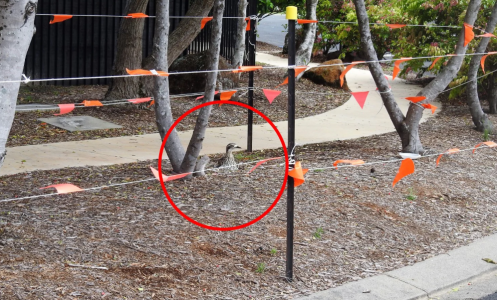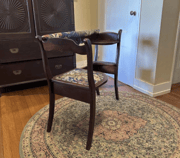Invasive species threat spreads to unexpected places, raising community concerns
By
Gian T
- Replies 0
If you’ve ever wandered through everyday spaces like a car park, schoolyard, or hospital garden and caught an eerie sound, you may have stumbled across a surprising presence hiding in plain sight.
A unique native bird is quietly adapting to life in unexpected places, its haunting call capturing attention as breeding season begins.
Now, conservation groups are urging communities to take notice, as a little awareness could make a big difference in protecting this remarkable species.
The bush stone-curlew is a master of camouflage. With its mottled grey and brown feathers, it can disappear into the background of gravel, mulch, or even a patch of dry grass.
Most people hear their eerie, wailing call long before they spot the bird itself. This clever disguise is a survival tactic, but it also means they’re at risk in our busy urban environments—especially during breeding season.
Amy Nicholls, Sustainability and Environment Project Officer from Tweed Shire Council, explains: ‘It’s breeding time, so now is the time to keep an eye out. They are well camouflaged, and it’s common to see them nesting in car parks, schools, workplaces, hospital grounds, and even caravan parks.’
While some might wonder why these birds would choose such exposed locations, Amy quickly points out that it’s not a matter of intelligence, but adaptation.
‘People say, "Why are they so stupid sitting in a car park?" But they’re not being stupid—they’re just adapting to what is now our urban environment. They prefer wide open spaces where they can spot predators from a distance,’ she said.
While bush stone-curlews are still relatively common in parts of Queensland, their situation is far more precarious in New South Wales and Victoria, where they’re listed as endangered.
In South Australia, they’re considered threatened. The main culprits? Road strikes, habitat loss, and predation by invasive species like foxes and cats, as well as attacks from domestic dogs.
‘We have seen huge amounts of losses due to vehicle strikes and attacks by domestic pets,’ Amy said.
The Tweed region, straddling the border between Queensland and New South Wales, is a critical stronghold for the species.
‘We’re at the top of NSW, so we have the most impact on the population of curlews back into the state.’
Local councils are urging residents to keep an eye out for these birds and their nests, especially in high-traffic areas.
If you spot a curlew or a nest, report it to your local council. Crews can then monitor the site, put up fencing, and install signage to alert others to the birds’ presence.
The good news? Communities are getting involved. ‘We have so many people out there who adore curlews,’ Amy says. ‘Once you’ve got a nesting pair in your space, you’ll see them throughout the year and beyond.’
Curlews nest in pairs and share parenting duties equally. One bird incubates the eggs while the other forages for food, repeating this process for the 28-day incubation period.
They can nest up to four times during the long breeding season, which runs from late July to January.
But the most vulnerable time is when the chicks are young. ‘That is a very sensitive period,’ Amy explained.
‘They don’t understand the threats of vehicles, and they’re especially hard to spot at night.’
There’s hope for the bush stone-curlew. Last month, the species made headlines when it was reintroduced to Victoria’s Phillip Island for the first time in 50 years.
After a 25-year campaign to eradicate foxes from the island, the curlews finally had a safe haven.
But with foxes gone, cars have become the number one threat, with several birds already lost to vehicle collisions in recent months.
 Have you spotted a bush stone-curlew in your neighbourhood? Maybe you’ve heard their haunting call at night, or even had a nesting pair take up residence nearby. We’d love to hear your stories and tips for living alongside these remarkable birds—share your experiences in the comments below.
Have you spotted a bush stone-curlew in your neighbourhood? Maybe you’ve heard their haunting call at night, or even had a nesting pair take up residence nearby. We’d love to hear your stories and tips for living alongside these remarkable birds—share your experiences in the comments below.
Read more: New roadside threat has experts urging action: ‘Please be mindful'
A unique native bird is quietly adapting to life in unexpected places, its haunting call capturing attention as breeding season begins.
Now, conservation groups are urging communities to take notice, as a little awareness could make a big difference in protecting this remarkable species.
The bush stone-curlew is a master of camouflage. With its mottled grey and brown feathers, it can disappear into the background of gravel, mulch, or even a patch of dry grass.
Most people hear their eerie, wailing call long before they spot the bird itself. This clever disguise is a survival tactic, but it also means they’re at risk in our busy urban environments—especially during breeding season.
Amy Nicholls, Sustainability and Environment Project Officer from Tweed Shire Council, explains: ‘It’s breeding time, so now is the time to keep an eye out. They are well camouflaged, and it’s common to see them nesting in car parks, schools, workplaces, hospital grounds, and even caravan parks.’
While some might wonder why these birds would choose such exposed locations, Amy quickly points out that it’s not a matter of intelligence, but adaptation.
‘People say, "Why are they so stupid sitting in a car park?" But they’re not being stupid—they’re just adapting to what is now our urban environment. They prefer wide open spaces where they can spot predators from a distance,’ she said.
While bush stone-curlews are still relatively common in parts of Queensland, their situation is far more precarious in New South Wales and Victoria, where they’re listed as endangered.
In South Australia, they’re considered threatened. The main culprits? Road strikes, habitat loss, and predation by invasive species like foxes and cats, as well as attacks from domestic dogs.
‘We have seen huge amounts of losses due to vehicle strikes and attacks by domestic pets,’ Amy said.
The Tweed region, straddling the border between Queensland and New South Wales, is a critical stronghold for the species.
‘We’re at the top of NSW, so we have the most impact on the population of curlews back into the state.’
Local councils are urging residents to keep an eye out for these birds and their nests, especially in high-traffic areas.
If you spot a curlew or a nest, report it to your local council. Crews can then monitor the site, put up fencing, and install signage to alert others to the birds’ presence.
The good news? Communities are getting involved. ‘We have so many people out there who adore curlews,’ Amy says. ‘Once you’ve got a nesting pair in your space, you’ll see them throughout the year and beyond.’
Curlews nest in pairs and share parenting duties equally. One bird incubates the eggs while the other forages for food, repeating this process for the 28-day incubation period.
They can nest up to four times during the long breeding season, which runs from late July to January.
But the most vulnerable time is when the chicks are young. ‘That is a very sensitive period,’ Amy explained.
‘They don’t understand the threats of vehicles, and they’re especially hard to spot at night.’
There’s hope for the bush stone-curlew. Last month, the species made headlines when it was reintroduced to Victoria’s Phillip Island for the first time in 50 years.
After a 25-year campaign to eradicate foxes from the island, the curlews finally had a safe haven.
But with foxes gone, cars have become the number one threat, with several birds already lost to vehicle collisions in recent months.
Key Takeaways
- The bush stone-curlew, a native bird well-camouflaged in urban settings, is now nesting in car parks, schools, workplaces and even hospital grounds as it adapts to city life, prompting a council warning for locals to keep an eye out during breeding season.
- While the curlew population is holding strong in parts of Queensland, it’s listed as endangered in New South Wales and Victoria, and threatened in South Australia, mainly due to road accidents, habitat loss and attacks by foxes, cats and domestic dogs.
- Tweed Shire Council is urging residents not only to be on the lookout for these birds and their nests, but also to report any sightings so crews can monitor, fence off and signpost nest sites to help protect both birds and the public.
- Conservation efforts, such as fox removal on Victoria’s Phillip Island, have enabled bush stone-curlews to return for the first time in 50 years, but vehicle strikes have now overtaken foxes as the top threat to their survival in some areas.
Read more: New roadside threat has experts urging action: ‘Please be mindful'








